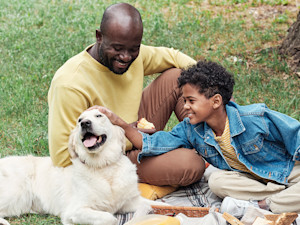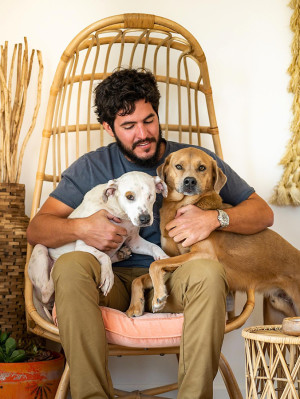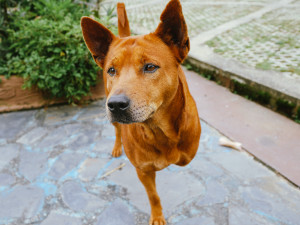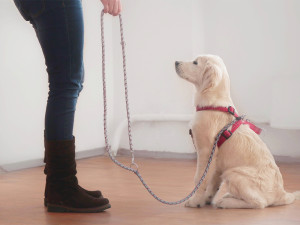The Pros and Cons of “Apartment Dogs”
Any of these breeds are great for city living and available at shelters and rescues.
In This Article:
Best Small Dogs for Apartments Best Medium and Large Dogs for Apartments
If you live in a city and are researching rescuing and adopting a dog, chances are you have run across the term “apartment breed” to try to find the breed or mix that is right for you.
These are the types of pups who are happy chilling on the couch between walks and can easily maneuver around a one-bedroom or studio. You might think only small dogs are a good fit for apartment life, but that’s not true. Animal behaviorist Renee Rhoadesopens in new tab, founder of R+ Dogsopens in new tab, stresses that many large breed dogs can adapt to apartment living quite well.
Save on the litter with color-changing tech that helps you better care for your cat.
“Any dog can be suited to apartment living as long as the dog guardian is making meeting the dog’s needs a priority,” Rhoades tells us.
As with any dog, there are good things and not-so-good things that prospective pet parents should take into account before making their final decision. To help take the guesswork out of it, we’ve created this guide for the pros and cons of some popular apartment dogs, both large and small, (and mixes of those breeds).
Dog apartment-training tips
All apartment dogs, big or small, will require certain training to exist safely and happily in busy, communal spaces. However, beyond training, there are three key factors that can set your dog up for success in an apartment.
Taking steps to establish routines
Dogs thrive with routines — and this goes double for those living in an apartment. A dog who knows when to expect walks, meals and playtime is a happier and calmer dog — and a better neighbor to those in your building.
Having a routine with your pup also allows you to account for certain variables that are common with apartment living — such as busy times in communal spaces or waves of kids going to or from school. Having a sense of these comings and goings and building your dog’s routine around them will help your pup succeed in your apartment.
Optimize the space.
Even in small spaces, pet parents need to ensure they can provide their pup with what they need to succeed in their training.
“It’s important if you welcome a dog into a smaller space that you are able to provide the dog with their own area as well as shared spaces,” Rhoades advises.
This can take the form of anything from a spare room, a crate, or even a bed — as long as your dog views that place as their safe space in the home.
You might also want to consider going the extra mile to be a good neighbor by putting down zoomie-proof rugs or squirrel-blocking curtains. This will ensure your dog is a welcome addition to your community, not a zooming, squirrel barking lunatic.
Prioritize mental and physical stimulation
“Many dogs, even those who have big houses and yards, are missing out on mental and physical stimulation leading to poor mental health and general welfare,” Rhoades tells us.
Mental and physical stimulation is key to ensuring your dog’s happiness in an apartment. Both these activities should be built into your dog’s routine and can include trips to the dog park, outside games, and inside puzzle or nosework toys. Most importantly, it requires built-in time for you to engage with your pup on their level — not just when you aren’t on a Zoom call.
Finally, even if you feel you can meet all these needs as a pet parent, it’s important to assess if your dog or prospective dog can handle the realities of apartment living.
“Something that we may not always consider when looking at dogs living in apartments is the experience for the dog in relation to other dogs in the immediate area,” Rhoades cautions. “Dogs can start to become sensitive to hearing other dogs bark or seeing dogs or people outside of their windows passing by. There can also be some concerns about dogs in elevators or stairwells especially considering when the dog gets older or interacting with other dogs in the building.”
Pet parents and prospective pet parents will need to take these factors into account when considering apartment living with their pets. The breeds on this list were chosen because of the commonly exhibited traits and behaviors associated with their breed that make them suitable for apartment living. These breeds are, on the whole, easy to house train, calm tempered, and not prone to barking — making them ideal choices when living in an apartment.
Small apartment dog breeds
According to Rhoades, the biggest benefit is the most obvious one: “Having smaller dogs in an apartment setting can sometimes be beneficial as smaller dogs take up less space.”
The hard truth is that smaller dogs can actually make it easier to find an apartment in the first place. Despite a new law banning home insurers from breed discrimination in places like New York, landlords will often deny a rental application based on a dog’s breed or size, with a common weight limit being 25 pounds.
And if your landlord has a no-pets policy, you have a better chance of convincing them to bend the rules if your dog is on the petite side — especially if they are one of those small- dog breeds that are calm and easy to train, like (most of) the ones on this list.
Mixed breeds
When looking to adopt any dog, apartment breed or not, you can find great mixed breeds at rescues. Many people are surprised to discover that shelters are full of all the breeds on this list, or better yet, a combo of these breeds. Mixed breed dogs can provide a best of both worlds scenario, like an easier-to-potty train Yorkie mix, or a low-shedding Dachshund.
Mixes that contain none of the breeds on this list can also thrive in an apartment living, such as a Pocket Pittie (aka Pit Bull-type mix) that usually comes in under 40 pounds. The biggest risk when it comes to mixed-breed dogs and apartment living is that temperament, size, and energy needs are more unpredictable. However, the staff at a shelter or rescue can usually provide guidance in this area, giving you a little more peace of mind before you bring your pup home.
Yorkshire Terrier
Yorkshire Terriers are an often recommended apartment breed due to their petite size, tipping the scales at just seven pounds. However, these originally British babes aren’t always perfect roommates. Like Dachshunds, Yorkies can be prone to barking. Unlike Dachshunds, their bark is a much more tolerable yap and therefore less likely to get you a noise complaint. Yorkies are also a good mix of energetic and low-key.
A few quick laps around your one-bedroom and these pups will happily nap on your lap for the rest of the day — and their size means those laps are less likely to bother your downstairs neighbor.
Potty training is the biggest issue with this breed, especially if you have to run down a fifth-floor walk-up before you make it outside. The hard truth is that you might need to invest in some pee pads for these petite pups and their even more petite bladders.
Dachshund
Dachshunds are a good yet sometimes questionable choice for apartment living for only one big, loud reason: barking. Relative to their small size, Dachshunds have a deep, resonant bark — and it’s one they like to employ frequently. Although early training can mitigate this breed instinct, it is unlikely to abolish it altogether. Dachshunds can, however, also make wonderful apartment companions. They are big couch potatoes who are happiest just being around their person (sometimes a little too happy, as they can also be prone to separation anxiety).
They also have one breed instinct that makes them uniquely perfect for apartment living: rodent hunting. Dachshunds were originally bred to hunt badgers and rodents, so they will happily try to catch any mouse your landlord won’t.
Cavalier King Charles Spaniel
You might be wondering, Are there going to be any silent dogs on this list? — and the answer is no because there are no completely silent dogs. And we wouldn’t want that anyway; barking is how our pups communicate. However, you will get pretty close with the Cavalier King Charles Spaniel, who are often chosen for their prized sweet and quiet dispositions.
But while these small pups are not big on barking, they do come with other caveats. Cavaliers are very one-person loyal and can, as a result, be prone to separation anxiety. Unlike their counterparts on this list, they aren’t one to bark about it — but your absence will still take a toll on the gentle breed. They also require more exercise than the other breeds here.
Bichon Frisé
These puffball pups can do really well with apartment living — under the right conditions. Bichons are small and light as a feather, usually under 15 pounds. They are also low energy, and their exercise needs are flexible and minimal. However, like the Yorkie, Bichons are notoriously difficult to potty train. They can also bark a lot, especially when left alone. And while their “hypoallergenic,” minimally shedding coat is perfect for small-space living, they do require more frequent baths and grooming — which can be a pain in a small apartment bathroom.
Mini Doodle
Doodles — the various Poodle mixes including, but not limited to, Goldendoodles, Labradoodle, and Bernedoodles — are easily the most controversial breed of the last 20 years. Mini versions of these pups are especially common in cities filled with apartment dwellers, mostly due to their quickly trainable temperaments and less allergenic coats. However, depending on which breed mix you get, the Doodle energy needs might be more than a few small rooms can handle.
Any working breed mix, such as the mini Aussie-doodles, is going to require frequent access to exercise and large open spaces to maintain a healthy temperament. Additionally, the rapid spike in popularity of these dogs has led to irresponsible breeding, meaning your perfect studio-sized mini-Doodle puppy might end up far less mini once they reach full adulthood.
Please remember you do not have to go to a breeder to find this breed (or any breed). You can find Doodles rescued from backyard breeders who need your love and attention.
Large and medium apartment dog breeds
If you’re up for the challenge of optimizing your apartment and schedule for a larger dog, Rhoades assures us that large dogs make for happy apartment dwellers.
“Depending on the exercise requirements of the individual dog many breeds could live great lives as apartment dogs. Dogs do not necessarily need backyards in order to have fulfilling lives but they do need to have guardians who are willing to accommodate their needs.”
In terms of temperament, there’s no shortage of large dog breeds who are chill enough to vibe with small-space living. And, while some breeds — cough cough Great Dane cough cough — might require a, uh, slightly bigger dog bed than, say, a Maltese, their low-key, amicable personalities make them perfect fits for apartment life.
Greyhound
Famous for their controversial history of track-racing, Greyhounds are an elegant breed that can adapt well to apartment living. Many Greyhound pet parents note their ironic lazy temperaments. This is because these dogs were bred to be sprinters, not endurance runners, making their exercise needs incredibly manageable. Of the best medium-sized dogs for apartments, Greyhounds are also generally a very quiet breed and are not prone to heavy barking fits.
All this said, prospective Greyhound parents should keep a few things in mind. One good point to remember is that a rescue Greyhound, who might come from the legal or illegal racing world, might struggle with potty training as, they likely have never lived indoors. Greyhounds can also be sensitive to noise, so those with upstairs neighbors who love to stomp or honking taxis outside the window should take note before adopting. In spite of these watch-outs, Greyhounds are highly trainable and can usually adapt if given enough time and patient training.
Golden Retriever
Golden retrievers are beloved for both their inner and outer beauty. Highly sociable, a Golden Retriever will likely adapt well to a busy, person- and dog-filled apartment building. Not usually big barkers or noise reactive, golden retrievers also make good neighbors in places with shared walls. There is also no reason to go to a breeder for these dogs; you can find them at a purebred rescue or at a shelter, often as a result of illegal, backyard breeding.
However, as their name suggests, Golden Retrievers will need structured exercise time to play fetch or just get out excessive energy. Aside from exercise, the whip-smart breed will also need mental stimulation inside your apartment — so be sure to invest in puzzles and nosework toys.
Great Dane
Ironically the largest breed on this list, Great Danes might be one of the best breeds for apartment living. Low-energy and stunningly gentle, Great Danes can live quite happily in communal, apartment living. Great Danes are also known for their infrequent barking and trainable nature. Of the best large dogs for apartments, Great Danes will likely require more accommodations than other large breeds on this list in order to comfortably adapt to apartment living.
For starters, Great Danes will still need an ample amount of living space in order to stretch their legs and wag their tail without wagging into stuff (seriously, their tails are huge and their wag is very powerful).
Furthermore, Great Danes are prone to certain health problems that can affect their mobility, such as hip dysplasia, arthritis, and wobbler syndrome. Especially as they age, these conditions can make it hard to navigate the breed, which can reach up to 200 pounds, up and down stairwells and elevators. All this said, Great Danes can live happy, comfortable lives in apartments — but would probably thrive best in a low-floor one bedroom rather than a walk-up 350 square foot studio.
Large mixed breeds
A mixed-breed pup is like getting the best of both worlds — or multiple worlds, depending on how many breeds your dog contains. Especially when it comes to large breeds, the good traits of one breed (i.e., a Great Dane’s laziness) can balance out the less desirable traits of the other (i.e., a Golden Retriever’s high-energy level) when it comes to apartment living.
Mixed breeds are also thought to be less prone to genetically-inherited mobility issues, such as hip dysplasia, which can already be common in large dogs. While not always the case, their lower risk for mobility issues can make them a safer bet for walk-up living. As for downsides, breed traits might be less “predictable” in mixed breeds, so it can be harder to know their suitability for apartment living until they’re actually living in one.
However, recent studies show that breed traits aren’t always as predictable as we once thought. Especially if they are a rescue or currently being fostered, a shelter worker or foster parent can give you insight into their personality and temperament as it relates to apartment living. Like any dog, mixed breeds are unique individuals and should be respected and treated as such.
FAQs (People also ask):
What are the best apartment dogs?
When deciding which dog is right for your family, there are a lot of factors to consider. Your home, climate, and the overall personality of you and your family will be the key variables to finding your perfect pup.
What is the quietest dog for an apartment?
While breed standards can only tell you so much when it comes to barking tendencies — breeds like Cavalier King Charles, Great Danes, and Greyhounds are known to be on the quieter side.
How do I train my dog to live in an apartment?
When it comes to apartment living, the pup parent might need more training than the pup. This is because a lot of apartment living with pets comes down to etiquette on the part of the human.
Even if you can control or guide your dog, you will not be able to control or guide the many people and variables that exist in the communal space around you. Avoiding or being cautious with your dog in common areas that might have young children or other non-predictable dogs is a good start — along with investing in a heavy, sound-muffling rug for those morning zoomies.












